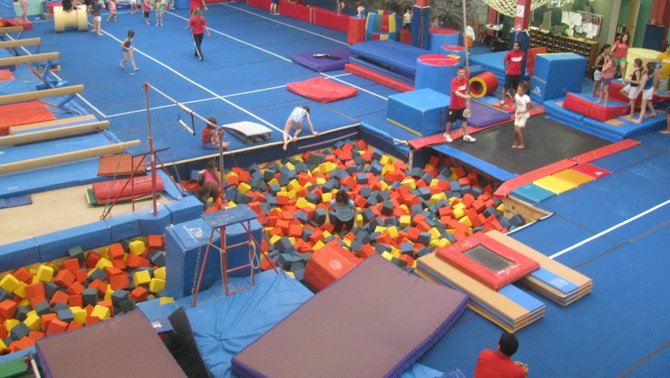Flame blocks that provide a soft landing for gymnasts contain flame retardants. Photo by Courtesy Flickr/Eden Pictures
This story appeared on Environmental Health News.
Eleven-year-old Katya Olsen has practiced gymnastics since she was two years old. Now in sixth grade, she trains for competitions four hours a day, five days a week at a gym near her home in Arlington, Va.
Katya's gym, like most, contains an enormous pit filled with thousands of foam blocks—a soft landing for gymnasts learning new tricks.
Now research suggests that young gymnasts may be exposed to hormone-disrupting chemicals from ingesting or inhaling dust created by these polyurethane blocks.
A small study of collegiate gymnasts detected four to 6.5 times more flame retardants in their blood than in the general U.S. population's.
"Our results suggest that the study gymnasts are highly exposed, but it's unclear what health risks, if any, they would face as a result of this exposure," said Courtney Carignan, lead author of the study published online last week in the journal Environmental Science & Technology.
The study suggests that "until now, we may have been underestimating exposure in certain high-risk groups," said Ami Zota, a reproductive health scientist at George Washington University who was not involved in the study.
Researchers from Boston University collected blood and hand-wipe samples from 11 female college-age gymnasts training at one gym in the Northeastern U.S. All participants reported practicing gymnastics for at least 12 years and at the time of the study, averaged 19 hours a week at the gym.
The gymnasts' blood contained levels of a compound called BDE-153 comparable to U.S. foam recyclers and carpet installers, groups with high occupational exposure. BDE-153 is a breakdown product of a flame retardant, commonly used in furniture foam that was banned in 2004.
Samples of dust and foam taken from the participants' gym and two other U.S. gyms suggest that the foam blocks—some of which were up to 20 years old—were the likely source. Hand-wipe samples from the gymnasts contained two to three times more of the banned polybrominated diphenyl ethers (PBDEs) and newer flame retardants after practice than before practice.
Previous studies have linked PBDEs, which may persist in the body for years after exposure, to neurological and reproductive effects in children exposed in the womb.
"Three previous studies have shown that higher exposure levels to PBDEs in early life are associated with lower scores on neurological tests in children, and the levels found in these gymnasts are much higher than among the general population," said Heather Stapleton, an environmental chemist at Duke University who co-authored the study.
It's unclear whether exposure at other important periods of development, such as puberty, would lead to similar findings.
Because the brominated compounds break down very slowly in the body, "these levels may represent past exposures, when they were spending more time in and around the foam pit learning new skills," said Carignan, a retired gymnast and a postdoctoral researcher at the Dartmouth Center for Children's Environmental Health and Disease Prevention Research.
The scientists said their findings cannot be generalized to all gymnasts because they sampled only 11 gymnasts—all college-level and practicing at one gym in one part of the country.
It is possible that some other factor, such as diet or low body fat, may have been responsible for the gymnasts' higher levels. However, the gymnasts had similar levels of other persistent pollutants, such as polycholorinated biphenyls (PCBs) and organochlorine pesticides, in their blood than other U.S. teens, suggesting that the higher levels of flame retardants were due to the gym environment, the authors wrote.
Flame retardants are added to polyurethane foam to meet a flammability standard set by California in the 1970s that intends to slow the spread of flames in furniture cushions. However, the state earlier this year announced plans to alter the standard so no chemicals would be necessary.
Gyms nationwide use the foam blocks even though "polyurethane foam is intended to be used with an upholstered cover in furniture," said Bob Luedeka, executive director of the Polyurethane Foam Association, an industry trade group.
"Polyurethane shouldn't be used in areas of public occupancy where there is no thermal barrier between the foam and potential ignition sources. Open pits are not a good use of polyurethane foam, though few alternative exist for the cushion it provides," he said.
Carignan recommends washing hands after touching gym equipment and showering after leaving the gym to reduce exposure. A study in office workers found that increased handwashing was associated with lower body burdens of flame retardants in office workers.
Katya's newest gymnastic move, called a giant, requires her to swing around the uneven bars in handstand position, like a spoke in a wheel. "I worry about injuries constantly. She's already had a split sternum," said her mother, Cynthia Palmer Olsen.
While such injuries are her primary concern for her daughter, she said that she also worries about toxic exposures.
At least once a week, the gymnasts "fluff" the pit, which means throwing out all the foam blocks from the pit and then tossing them back in, to prevent them from getting too packed together at the bottom, stirring up a cloud of dust in the process.
"Our girls face high risk already with all their death-defying tricks. Why compound those risks?" Palmer Olsen said.


